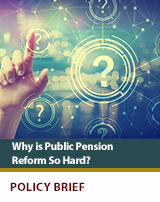POLICY BRIEF: Why is Public Pension Reform so Hard?
KEY POLICY INSIGHT: The single biggest issue for public pension policy design is the misalignment of interests between policymakers and other constituencies. The short-term budget constraints faced by policymakers are at odds with the long-term interests of taxpayers and beneficiaries. Using analytic frameworks, policymakers, union leaders, and other stakeholders can analyze the welfare and state budget implications of alternative pension policies.
• Investment risk-taking by public funds has been driven by slow-moving target returns.
• Prolonged periods of below trend economic growth put pressure on target returns and pension funding.
• Wage increases for beneficiaries can be found to make them indifferent between DB and DC systems.
• Taxpayers are underwriting insurance for beneficiaries.
• The effects of pension policy can be analyzed using the tools of modern economic analysis.
This issue is compounded by three additional quirks of public pensions. First, many states have constitutional prohibitions on changing benefits. In these states, once a retirement benefit has been guaranteed, it must be paid. Second, public fund accounting allows policy makers to pick the interest rate used to value their obligations. Again, short-term budget requirements provide an incentive to choose a higher interest rate — the higher rate reduces the value of the guarantee and consequently lowers the required levels of contributions. Finally, as distinct from U.S. corporate plans or the pension systems in other countries, there are no external forces setting the interest rate and the target return on assets, or assigning penalties for underfunding.
Against this backdrop, it is not surprising that public pension funds face funding pressures, nor that reform is so challenging. And, it should be clear that true reform of public pensions requires the alignment of incentives between policymakers, taxpayers, and beneficiaries.
WHAT MAKES A SUCCESSFUL PENSION REFORM
Any reform has to acknowledge the difficulty of changing policymaker’s short-term incentives. Hence, there are three key components to successful reform of public pensions. The first is risk-sharing across generations, the second is better pension policy design, and the third is increased wages for public employees. These three elements are interdependent.
Under current DB systems, taxpayers underwrite the risk of any shortfalls in pension funding without receiving any of the benefits of funding surpluses. An alternative is to introduce some level of volatility in beneficiary retirement income. Doing so reduces the risk to taxpayers. In some states (e.g. Rhode Island and Oklahoma), this step has been achieved through the introduction of a full or hybrid defined contribution (DC) plan. There are, however, other ways of achieving the same goal (e.g. collective Defined Contribution).
Shifting to a DC-type system means that beneficiaries are responsible for savings and investment decisions. The early experience with corporate DC plans suggests that beneficiaries either don’t save enough and/or invest in inappropriate vehicles. Responsible policy design should include default savings rates and default investment vehicles (both with opt out options). States such as Rhode Island and Oklahoma have included these features in their policy reforms.
Finally, successful reforms require an increase in public employee compensation, say in the form of an increased contribution to retirement savings. It should be self-evident that public employees should receive something in exchange for giving up a guaranteed retirement income. Again, pension reforms in Oklahoma and Rhode Island have included increased compensation as part of their reforms.
All parties can gain from this type of reform. Beneficiaries gain because they receive an increase in compensation and a well-designed savings and investment program. Despite the increased compensation to public employees, taxpayers gain because they are no longer underwriting uncompensated insurance. Finally, policymakers gain because they have more predictable short-term budgets. With more predictable budgets, policymaker’s time can be spent on issues like ensuring access to better structured annuity products (an issue that affects both public and private workers).
WHERE DO WE GO FROM HERE?
Although there are challenges, public pensions can be, and should be, reformed. Two points should be self-evident: first, public employees provide important services, and second, the present system is not delivering value to all constituencies. The single biggest issue that must be corrected is the misalignment of interests between policymakers and other constituencies. Through no fault of their own, the short-term budget constraints faced by policymakers are at odds with the long-term interests of taxpayers and beneficiaries, at least in the case of public pensions.
Addressing public pension policy should be made easier by the wider availability of modern analytic tools. Policymakers and union leaders can easily get access to analytic frameworks that incorporate the latest advances in financial economics and risk management. These tools can, and have been, put to use to analyze the welfare and state budget implications of alternative pension policies.
• Brief 1: Time for a Fresh Look at Pension Design
• Brief 2: Lifecycle Portfolio Choice and Pension Design
• Brief 3: Pension Reform for Aggregate Welfare
• Brief 4: Slow Growth is Bad News for U.S. Pension Investors
• Brief 5: Understanding Retirement Income Risk
• Brief 6: Risk-taking by Public Pension Funds
• Brief 7: Solving Practical Issues in Public Pension Design
• Brief 8: What Does it Take to Build a Better Retirement System?
• Brief 9: The Cost of Public Pension Funds to Taxpayers
• Brief 10: Public Pension Reforms Can Improve Economic Welfare
Read the full series at: z.umn.edu/pensions
1 This figure comes from a study by Moody’s. It received coverage in the Wall Street Journal July 30, 2018.
2 Most public defined benefit plans have deficits. A government might choose to run a persistent deficit because they do not want to offer increased benefits.
3 In most public funds, contributions are labeled as employer- or employee-provided. The distinction isn’t really relevant, as taxpayers ultimately fund both.
4 It could reasonably be argued that taxpayers and beneficiaries would be better off if policymakers would commit to a specific policy and stick with it. This is what economists call a commitment technology. Unfortunately, it is difficult to bind the decisions of one legislative session with the actions of previous legislatures.
5 This tension between the long-term interests of beneficiaries and taxpayers, versus the short-term interests of policymakers is an example of what economists call the problem of time consistency.
6 Public fund and actuarial treatment still allow the target rate of return on assets to be used to value pension obligations.
AUTHORS:
JORDAN PANDOLFO is a graduate student in the Department of Economics at the University of Minnesota.




